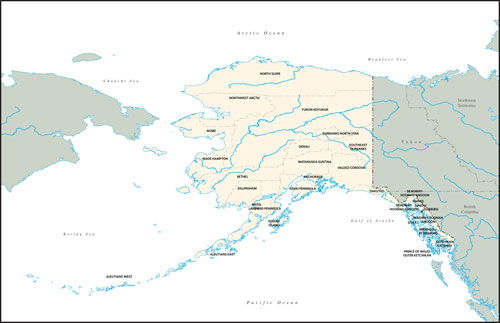Sign up for the Family Tree Newsletter! Plus, you’ll receive our 10 Essential Genealogy Research Forms PDF as a special thank you.
Get Your Free Genealogy Forms
"*" indicates required fields
Historical Overview
Although Alaska didn’t become part of the United States until 1959, joining as the 49th state, it was home to the very first Americans. Asians from Siberia crossed the Bering Strait between 21,000 and 42,000 years ago. Those who stayed became the precursors of Alaska’s native peoples—the Athabascans, Haida, Tlingit and Inuit (often called “Eskimos”). Native American records include a collection of Genealogical Records of Barrow Eskimo Families and Juneau Area Agency records (1905-1964), both on microfilm at the Family History Library (FHL), and the Oregon Province Archives of the Society of Jesus Alaska Mission Collection (1853–1960) at Gonzaga University in Spokane, Wash., also on FHL microfilm.
The first Europeans came to Alaska from Russia with Vitus Bering’s expedition in 1741, and sea-otter hunters arrived soon after. The Russian Orthodox church came to Kodiak in 1795, and remained dominant until the 20th century. Archives for the Diocese of Alaska were given to the Library of Congress in 1927; translated and microfilmed, these are available through the FHL.
Although the $7.2 million US purchase of Alaska from Russia in 1867 became known as “Seward’s Folly,” the Russians—strapped for cash after the Crimean War—knew the area was rich in gold, already found in 1861 near Telegraph Creek. A series of subsequent strikes sparked the Alaska Gold Rush, which brought 50,000 fortune-seekers between 1897 and 1920. Gold miners founded Nome in 1899 and Fairbanks in 1902. After a period under the jurisdiction of the War Department (1867–1877) and the Treasury Department (1877–1884), Alaska became a US District in 1884 and a territory in 1912.
World War II brought a fresh wave of migration to Alaska with 140,000 US military stationed there, some of whom stayed. Not long after statehood, Alaska’s “black gold” rush began with oil at Prudhoe Bay in 1968. Even so, the largest state geographically remains the least densely populated.
County Map
Research Tips
- It’s crucial to understand the state’s geography and history, including the dates of the various gold rushes.
- The National Archives in Anchorage has a large collection of records generated by the federal government since statehood (1959). Prior to statehood, the collections are divided between it and the state library and archives.
- Visit the Alaska and Polar Regions Department, Elmer E. Rasmuson Library, University of Fairbanks. The site links to the Alaska and Polar Periodical Index, which is an index to periodicals containing articles about Alaska and Alaskans.
Census Records
- Federal census 1900, 1910, 1920, 1930
- Territorial census: Sitka, 1870, 1880, 1881
General Resources
- Alaska, 1741–1953 by Clarence Charles Hulley (Binfords & Mort, 1953)
- Alaska, a Bicentennial History by William R. Hunt (Norton, 1976)
- The Alaska Gold Rush by David Wharton (Indiana University Press, 1972)
- The Alaska Handbook by R.K. Woerner (McFarland, 1986)
- Alaska, a History of the 49th State, 2nd edition, by Claus M. Naske and Herman E. Slotnick (University of Oklahoma Press, 1987)
- Alaska and Its History compiled and edited by Morgan B. Sherwood (University of Washington Press, 1967)
- The Alaska Newspaper Tree by William R. Galbraith (Elmer Rasmuson Library, 1975)
- Alaska Research Outline by the Church of Jesus Christ of Latter-day Saints
- Alaska Sources: A Guide to Historical Records and Information Sources by Connie Malcolm Bradbury and David Albert Hales (Heritage Quest, 2001)
- Alaska Women’s Oral History Collection: Catalogue with Subject Index compiled by Maria Brooks (Learning Resources Center at Anchorage Community College, 1983)
- The Alaska-Yukon Gold Book; A Roster of the Progressive Men and Women who were the Argonauts of the Klondike Gold Stampede … (Sourdough Stampede Association, Inc., 1930)
- Alaskan Census Records, 1870–1907 edited by Roland Vern Jackson and Gary Roland Teeples (Accelerated Indexing Systems, 1976)
- Alaskan Maps: A Cartobibliography of Alaska to 1900 by Marvin W. Falk (Garland Pub., 1983)
- The Alaskan Russian Church Archives by Antoinette Shalkop (Manuscript Division, Library of Congress, 1984)
- Bibliography of Books on Alaska Published Before 1868 by Valerian Lada-Mocarski (Yale University Press, 1969)
- Biographies of Alaska-Yukon Pioneers, 1850–1950 compiled and edited by Ed Ferrell (Heritage Books, 1994–2000)
- The Dictionary Catalog of the Pacific Northwest Collection of the University of Washington Libraries, Seattle from the University of Washington Libraries (G.K. Hall, 1972)
- Documenting Alaskan History: Guide to Federal Archives Relating to Alaska by George S. Ulibarri (University of Alaska Press, 1982)
- The Founding of Juneau by R.N. DeArmound (Gastineau Channel Centennial Association, 1967)
- History of Alaska, 1730–1885 by Hubert Howe Bancroft (A.L. Bancroft & Co., 1886)
- How to Find Your Gold Rush Relative: Sources on the Klondike and Alaska Gold Rushes (1896–1914) compiled by R. Bruce Parham and the Alaska Gold Rush Centennial Task Force (National Archives, 1997)
- An Index of Alaska Oral History Collections compiled by the Program for the Preservation of Oral History and Traditions, Alaska and Polar Regions Department, University of Alaska, Fairbanks (The Program, 1986)
- Melvin Ricks’ Alaska Bibliography: An Introductory Guide to Alaskan Historical Literature by Melvin Byron Ricks, edited by Stephen W. Haycox and Betty J. Haycox (Binford & Mort for the Alaska Historial Commission, 1977)
- Russian America: A Biographical Dictionary by Richard A. Pierce (Limestone Press, 1990)
Return to the main Alaska page
From the Family Tree Sourcebook
Also available: the State Research Guide Book, State Research Guides CD and The Researcher’s Guide to American Genealogy.


